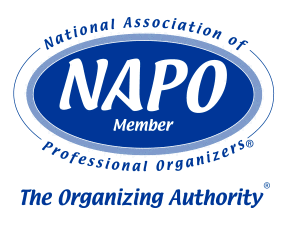 I recently spent four days at the National Association of Professional Organizers (NAPO) conference (yes, there really is such a thing!) in Los Angeles. It was an incredible time, filled with camaraderie and education, and I came back with a four-page “to do” list. Most of the items on the list were reminders of things I wanted to do to advance my business (networking, refining e-mail lists, update website, etc.). Some of the items on my list were more in support of personal growth (research meditation, try some white noise apps for better sleep, etc.).
I recently spent four days at the National Association of Professional Organizers (NAPO) conference (yes, there really is such a thing!) in Los Angeles. It was an incredible time, filled with camaraderie and education, and I came back with a four-page “to do” list. Most of the items on the list were reminders of things I wanted to do to advance my business (networking, refining e-mail lists, update website, etc.). Some of the items on my list were more in support of personal growth (research meditation, try some white noise apps for better sleep, etc.).
When I made the list, I was motivated. Now that I’ve had a couple of weeks to work the list, I’ve learned a lot about myself and the process of working through “to do” lists. What works; what doesn’t work. How to measure success; how to not get frustrated. How to re-frame “to do” lists into “things I want to do” lists.
I hope some of what I learned will resonate with you also.
Re-frame how you think about the list. The first thing I needed to do was to re-frame the way I thought about my “to do” list. I needed to make my list more pleasant, less chore-like. Yes, there were critical tasks on my list, but there were a lot of things on my lists that I just flat out wanted to do. So, I’ve renamed my list “Things I Want To Do” (TIWTD) vs just “To Do.” I also put a beautiful picture of crashing waves at the top of the list, changed to a softer font style, and incorporated a beautiful light blue font and line color. Now looking at my list makes me smile not cringe.
Do a brain dump. The first step to putting together a TIWTD list is to do a brain dump of anything and everything that comes to mind. It may be as small as “call Mom” or as large as “plan a trip to the Grand Canyon.” Whatever it is, the chance it will get done is much greater if you document it.
Is it a task or a project?
Sometimes frustration sets in when we can’t check items off our list fast enough because they are too big or too daunting. Generally, those items are projects not tasks. For example, to some people “Change car oil” is a task because they do it themselves and they have all the tools and supplies to get the job done. For others, this same item may be a “project” as it entails the following tasks:
1. Find a mechanic.
2. Make an appointment.
3. Find a friend to drive them to/from the mechanic.
Each of these items are a “task” that need to be completed as part of the larger “project.” Breaking larger projects down into tasks will help motivate you through the process.
Assign an estimate of how long you think the task will take. A lot of the items on my post-conference list were tasks that could be accomplished in less than five minutes (e-mail individual colleagues I met at conference, confirm client appointments, print handouts, etc.). Other tasks would take more time (research 501(c)3 annual meeting requirements, create mailer for ADHD therapists, etc.). Once I’ve assigned a timeline to each task, I can quickly assess which ones to tackle based on the amount of time I have available.
Prioritize the list. It’s important to put those items that will move you forward personally or professional at the top of the list. There are items on my post-conference list that don’t need to be a done for a couple months; others need to be done now in order to move my business forward. Identify the priorities and start there.
Set aside task time. It’s critical to set aside time to work through your TIWTD list. Even those five-minute tasks need to have dedicated time for them to get accomplished. Make and keep an appointment with yourself to work through your list. I find it helpful to set a timer and eliminate distractions just as if I were having a meeting with a client.
Also think about items that you can do outside your office and take supplies with you. For example, you can make dentist appointments while you are waiting to pick up your children from school or you can text the babysitter while you are waiting in line at the post office.
Let it go. Sometimes we put things on our list that become unimportant and unnecessary with time. When you identify those items, it’s okay to just scratch through them and move on. Let them go!
I wish you luck in moving things from the “Things I Want To Do” list to a “look what I got done” list!
 National Association of Professional Organizers, Seattle Chapter President
National Association of Professional Organizers, Seattle Chapter President
 Certified Premium Subscriber, Institute for Challenging Disorganization
Certified Premium Subscriber, Institute for Challenging Disorganization